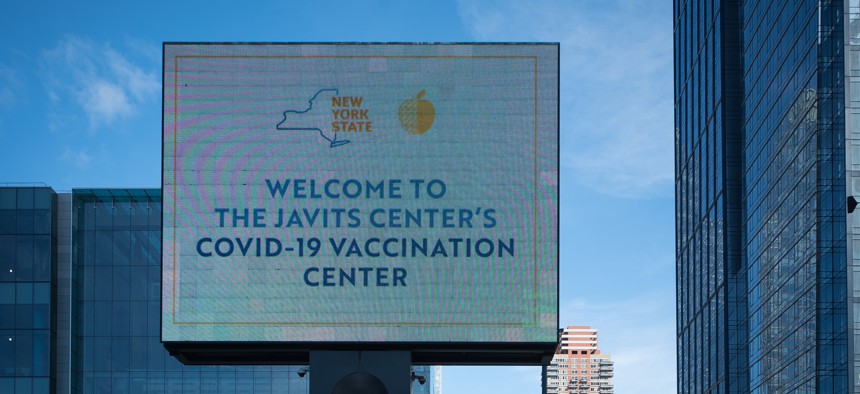These Steps Can Help Build Trust in Vaccination Programs

Digital billboard outside the The Jacob K. Javits Convention Center in New York City now a state vaccination center. iStock.com/Massimo Giachetti
COMMENTARY | States and localities should prioritize using clear, science-based communication, restoring trust and providing better data to address the hesitancy some people have about getting the Covid-19 vaccine.
State and local leaders are heavily focused on vaccine distribution to get the Covid-19 pandemic under control. Yet, political strife and public health restrictions have divided the American public and eroded trust in government at every level—leaving public officials in a difficult position as they attempt to carry out mass vaccination programs.
A study conducted by Harvard, Northeastern, Rutgers and Northwestern universities last August found that only 59% of respondents said they would get a Covid-19 vaccine, which was a decrease of six points from a survey completed just weeks prior. However, there is evidence from a more recent Kaiser Family Foundation study that the Food and Drug Administration approval of two vaccines has increased public trust and 71% of Americans intend to get vaccinated.
More broadly, there are troubling signs for the current level of public trust in government. According to the survey that the group of universities conducted, public trust in state government stood at 68%, the White House 46% and Congress just 42%, and each saw declines of between 12 and 13 points since the spring.”
State and local governments can begin to overcome these trust deficits and aid vaccine distribution efforts by identifying trusted sources to communicate to the public.
Specifically, scientists and public health experts maintain higher levels of trust (85%) than political figures and government institutions making them some of the best messengers. A recent article in the journal Nature noted that one of the most effective strategies for scientific communications is to deliver messages through sources the recipients believe to be credible, and that “helping people feel knowledgeable” about public health encourages behavior change. Similarly, local officials—who are better known in their communities—often have the trust of their constituents and can amplify messages from public health officials to add another layer of credibility.
While finding trusted sources will help with vaccination efforts in the short-term, government and public sector institutions still need to rebuild trust with citizens. Transparency and clarity are key aspects of this.
Data visualizations are one way that governments can improve how they communicate pandemic data and response measures. Dozens of states and counties have created dashboards that help citizens easily see and understand the day-to-day evolution of the pandemic, the local measures in place to control disease spread, Covid-19 testing sites and now vaccination rates. The most successful dashboards combine interactivity, clear insights, guidance and regular updates that provide a valuable experience for citizens to keep coming back to and make informed decisions in their own lives.
Delivering clear information from the scientific community, in easily understandable visualizations that will help people feel better informed, can rebuild trust and increase compliance with response measures to the pandemic. Reinforcing this information with messaging delivered by local public health officials and other trusted figures will be key to an effective vaccination effort and getting the pandemic under control.
Graham Stroman is the vice president of sales, U.S. State & Local Gov't and Education (SLED) at Tableau Software.
NEXT STORY: A Las Vegas Judge Approves $1.4 Million Payment to Wrongfully Convicted Man Who Served More Than Two Decades





